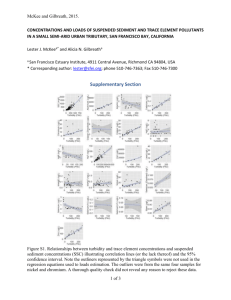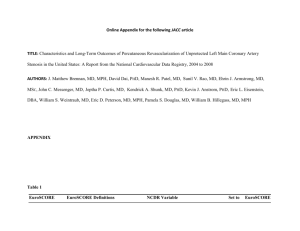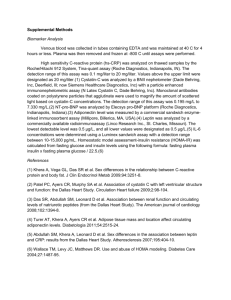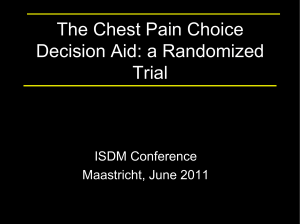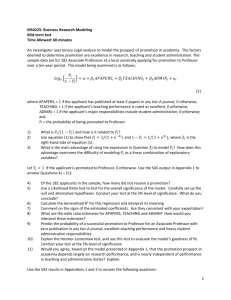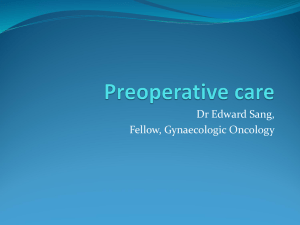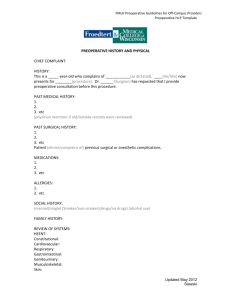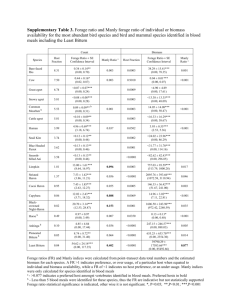Online Appendix for the following JACC article TITLE: Growth
advertisement
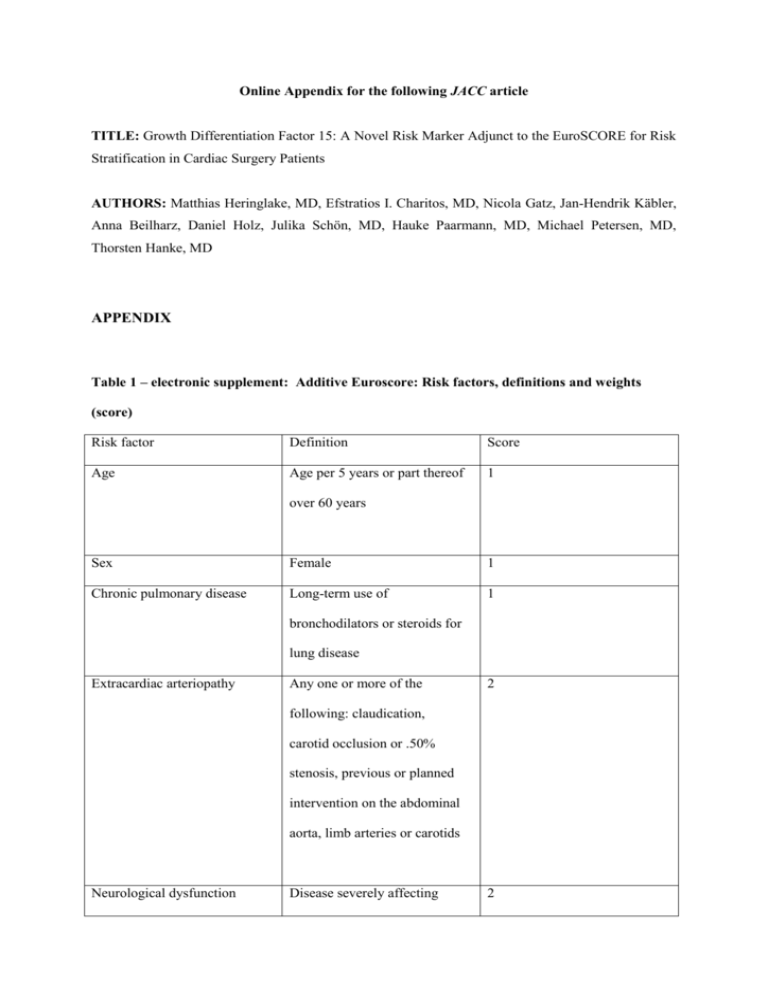
Online Appendix for the following JACC article TITLE: Growth Differentiation Factor 15: A Novel Risk Marker Adjunct to the EuroSCORE for Risk Stratification in Cardiac Surgery Patients AUTHORS: Matthias Heringlake, MD, Efstratios I. Charitos, MD, Nicola Gatz, Jan-Hendrik Käbler, Anna Beilharz, Daniel Holz, Julika Schön, MD, Hauke Paarmann, MD, Michael Petersen, MD, Thorsten Hanke, MD APPENDIX Table 1 – electronic supplement: Additive Euroscore: Risk factors, definitions and weights (score) Risk factor Definition Score Age Age per 5 years or part thereof 1 over 60 years Sex Female 1 Chronic pulmonary disease Long-term use of 1 bronchodilators or steroids for lung disease Extracardiac arteriopathy Any one or more of the 2 following: claudication, carotid occlusion or .50% stenosis, previous or planned intervention on the abdominal aorta, limb arteries or carotids Neurological dysfunction Disease severely affecting 2 ambulation or day-to-day functioning Previous cardiac surgery Requiring opening of the 3 pericardium Serum creatinine > 200 mmol/l preoperatively 2 Active endocarditis Patient still under antibiotic 3 treatment for endocarditis at the time of surgery Critical preoperative state Any one or more of the 3 following: ventricular tachycardia or fibrillation or aborted sudden death, preoperative cardiac massage, preoperative ventilation before arrival in the anaesthetic room, preoperative inotropic support, intraaortic balloon counterpulsation or preoperative acute renal failure (anuria or oliguria,10 ml/h) Cardiac-related factors: Unstable angina Rest angina requiring i.v. 2 nitrates until arrival in the anaesthetic room LV dysfunction Moderate or LVEF 30 to 50% 1 Poor or LVEF < 30 3 3 Recent myocardial infarct (< 90 2 days) Pulmonary hypertension Systolic PA pressure > 60 2 mmHg Operation-related factors: Emergency Carried out on referral before 2 the beginning of the next working day Other than isolated CABG Major cardiac procedure other 2 than or in addition to CABG Surgery on thoracic aorta For disorder of ascending, 2 arch or descending aorta Postinfarct septal rupture 4 Table 2 – electronic supplement Relationship between preoperative Growth-differentiation-factor-15, demographics, and variables representative of cardiovascular status and/or risk. Variable Spearman’s rank test / significance coefficient of contingence age 0.46 (0.42 to 0.5) p<0.0001 sex 0.04 * P=0.150 body mass index -0.03 (-0.08 to 0.02) P = 0.175 surgical priority urgent/emergency 0.138 * P<0.0001 CABG vs. NO-CABG 0.02 * p=0.521 LVEF <30% 0.2 * P=0.0872 eGFR -0.48 (-0.52 to -0.44) p<0.0001 NTproBNP 0.5 (0.46 to 0.54) p<0.0001 hsTNT 0.52 (0.48 to 0.56) p<0.0001 NTproBNP: N-terminal pro B-type natriuretic peptide; CABG: coronary artery bypass grafting; eGFR: estimated glomerular filtration rate; IABP: intraaortic balloon pump; LVEF: left ventricular ejection fraction; hsTNT: high-sensitive troponine-t. *: Coefficient of contingence: Chi-Square test. Table 3 electronic supplement: Cox proportional hazards regression for 1-year mortality Total cohort Elective patients N = 1438 N = 1196 Covariate Hazard ratio Additive 1.2327 significance Hazard ratio 1.2842 P < 0.0001 P < 0.0001 Euroscore (1.1709 to 1.2979) (1.1980 to 1.3767) NTproBNP Not included Not included in the model in the model 1.0001 Not included hsTNT significance P = 0.0579 (1.000 to 1.0002) GDF-15 in the model 1.0553 1.1571 P < 0.0001 (1.0288 to 1.0824) P < 0.0001 (1.1002 to 1.2170) Duration of 1.0018 Not included P = 0.0247 surgery (1.0002 to 1.0033) Chi Square 122.811 in the model P < 0.0001 72.542 P < 0.001 Cox proportional hazards regression employing the additive Euroscore, N-terminal pro B-type natriuretic peptide (NTproBNP), high sensitive troponin T (hsTNT), Growth-differentiation factor 15 (GDF-15), and duration of surgery as continuous variables. Data are given as Hazard ratios with 95% confidence intervals. Table 4 electronic supplement: Net-reclassification improvement of additive Euroscore with GDF-15 for 1-year mortality. a. Updated model (risk categories) % patients reclassified Initial model (risk categories) OUTCOME ABSENT 0 - 2% 2–5% 5 – 10% 10 - 100% 0 – 2% 255 3 10 0 5 2- 5% 111 278 29 19 36 5 – 10% 0 259 82 77 80 10 – 100% 0 0 84 122 41 b. Updated model (risk categories) % patients reclassified Initial model (risk categories) OUTCOME PRESENT 0 - 2% 2–5% 5 – 10% 10 - 100% 0 – 2% 4 0 2 0 33 2- 5% 6 3 2 3 79 5 – 10% 0 8 2 17 93 10 – 100% 0 0 11 51 18 Net-reclassification improvement (NRI) for 30 day mortality between the additive Euroscore predicted mortality risk categories (initial model) and the additive Euroscore with Growth-differentiation factor 15 (GDF-15) employing a cut- off level ≥ 1.8 ng/ml (updated model). The addition of GDF-15 resulted in a NRI of 0.2286 (95% C.I.: 0.0977 to 0.3595, p=0.00062.) and an integrated discrimination improvement of 0.0433 [95% C.I.:0.027 to 0.0596, p<0.0001)

